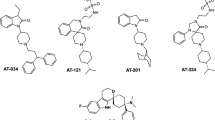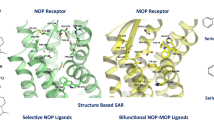Abstract.
Phe4 in the nociceptin (NC) sequence has been identified as the most critical residue for receptor interaction. In the present study, we investigated the pharmacological activity of a series of NC(1-13)NH2 analogues, in which the hydrogen atom in the para position of Phe4 was substituted with F, NO2, CN, Cl, Br, I, CH3, OH or NH2.
In receptor binding studies, performed using CHO cells expressing the recombinant human NC receptor (CHOhOP4) and in rat cerebral cortex membranes, [(pF)Phe4]NC(1-13)NH2, [(pNO2)Phe4]NC(1-13)NH2, and [(pCN)Phe4]NC(1-13)NH2 displayed higher affinity than NC(1-13)NH2. The affinity of [(pCl)Phe4]NC(1-13)NH2 was essentially identical to that of NC(1-13)NH2, while the remaining compounds displayed reduced affinity. In a series of functional assays (stimulation of GTPγS binding in CHOhOP4 cells and rat cerebral cortex membranes and inhibition of cAMP accumulation in CHOhOP4 cells), the para substituted analogues behaved as full agonists (with the exception of [(pOH)Phe4]NC(1-13)NH2 which acted as a partial agonist in the GTPγS binding assays) with the following rank order potency:
\({\rm pF = pNO}_{\rm 2} \ge {\rm pCN} \ge {\rm NC = NC(1 - 13)NH}_{\rm 2} {\rm = pCl} \ge {\rm pBr > pI = pCH}_{\rm 3} {\rm > pOH > pNH}_{\rm 2} \)
[(pF)Phe4]NC(1-13)NH2 and [(pNO2)Phe4]NC(1-13)NH2 were either inactive or displayed micromolar potencies in cAMP accumulation experiments performed on cells expressing classical opioid receptors. All compounds were full agonists in isolated tissues from various species (guinea pig ileum, mouse colon and mouse/rat vas deferens) with the exception of [(pOH)Phe4]NC(1-13)NH2 which displayed partial agonist/weak antagonist activities. The rank order of potency was similar to that found in the other assays. The effects of all analogues were not modified by naloxone. The selective OP4 receptor antagonist [Nphe1]NC(1-13)NH2, tested in all preparations against one or both of the highly potent derivatives [(pF)Phe4]NC(1-13)NH2 and [(pNO2)Phe4]NC(1-13)NH2, showed pA2 values similar to those found against NC, the pA2 in the GTPγS binding/rat cerebral cortex assay being much higher (ca. 7.5) than in the other functional assays (ca. 6).
This study further supports the notion that Phe4 of NC is the critical residue for receptor occupation and activation. Moreover, as part of this study, we have identified two novel, highly potent and selective agonists for the OP4 receptor, [(pF)Phe4]NC(1-13)NH2 and [(pNO2)Phe4]NC(1-13)NH2.
Similar content being viewed by others
Author information
Authors and Affiliations
Additional information
Electronic Publication
Rights and permissions
About this article
Cite this article
Bigoni, R., Rizzi, D., Rizzi, A. et al. Pharmacological characterisation of [(pX)Phe4]nociceptin(1-13)amide analogues. Naunyn-Schmiedeberg's Arch Pharmacol 365, 442–449 (2002). https://doi.org/10.1007/s00210-002-0548-8
Received:
Accepted:
Issue Date:
DOI: https://doi.org/10.1007/s00210-002-0548-8




